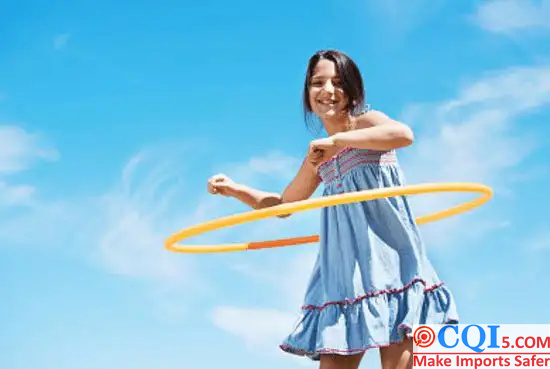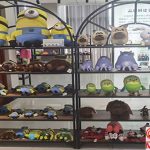What Does The Hula Hoop Inspection Standard Include?

Hula hoop, even a toy, is a kind of fitness equipment. It originated from the 20th century and is a kind of wooden circular toy popular among children in North America. At that time, its use method was to put it on the buttocks and play around. Later, people began to replace the wooden hoop with lighter and more colorful polyethylene materials, and promoted the play method from the buttocks to the waist in advertisements.
Hula hoop is suitable for a wide range of people, and people can buy it through various channels. Nowadays, people are always overwhelmed by various colors and materials. So how should people choose a safe and compliant hula hoop? How does the factory check the product quality of hula hoop? What is the inspection standard of hula hoop in the industry?
CQI combined daily work and compiled relevant industry inspection standards, and compiled this hula hoop inspection standard.
This paper briefly introduces the product classification, requirements, test methods, inspection rules, instructions for use, packaging, transportation and storage of hula hoop.
This paper meets the basic requirements of CQI inspection for hula hoop inspection.
Hula Hoop Classification
Usually hula hoop is made up of individual components, which can be spliced at will, and is usually made of NBR foam tube.
Now the common hula hoops on the market are:
Traditional hula hoop (soft and hard), multifunctional spring hula hoop, foldable hula hoop.
Hula Hoop Inspection Standards And Raw Material Requirements
All accessories of hula hoop shall be made of materials conforming to national standards.
Hula Hoop Inspection Standards And Inspection Requirements
1.Appearance requirements
(1) The appearance of the product shall be free from serious deformation, uniform in color, clean and pollution-free. The exposed surface shall be free of defects such as flash, burr and blistering. There should be no obvious difference in the colors of splicing single segments of the same color, and the special requirements should be implemented in the supply and demand contract.
(2) The accessible surface of the whole hula hoop should be smooth without obvious flash, edges and burrs.
2.Assembly performance
(1) The splicing places of hula hoops should be basically symmetrical without obvious dislocation, and the height difference between two different single segments at the splicing place should be no more than 5 mm..
(2) The splicing places of hula hoops should be firm and not loose after normal splicing, and the flatness deviation of the whole hula hoops should be no more than 50 mm..
(3) After splicing, the roundness deviation of the whole hula hoop in the natural state should be no more than 25mm. The pull-out force of a single splice should be not less than 20N.
(4) The spliced hula hoop has been subjected to free drop test at any position with a height of 1.0mm for 3 times at room temperature, and the hula hoop should not come loose or have defects that affect its use.
3.Massage bump (applicable to functional hula hoop)
(1) Massage bumps should be moderate in hardness and comply with the design requirements, and special requirements should be implemented according to the supply and demand contract.
(2) The massage bump is firmly connected with the hula hoop body and should not fall off during normal use.
Hula Hoop Inspection Standards And Test Methods
1.Specifications, dimensions and form and position tolerances
(1) The outer diameter of the hula hoop, the diameter of the connecting single section and the dislocation size of the splicing place shall be detected by measuring tools with corresponding accuracy according to the provisions of GB/T 3177, and the detection result of the dislocation size shall be accurate to 6.5mm, and the detection result of other sizes shall be accurate to 1 mm..
(2) The flatness deviation and roundness deviation of the integral hula hoop should be flat on the flat plate before testing, and then tested according to the corresponding provisions of GB/T1958.
2.Pull-out force of single splice joint
The pull-out force of a single spliced joint shall be tested on a tensile testing machine according to the provisions of GB1040 under the condition of clamping and hanging with a proper fixture, and the tensile speed shall be controlled within the range of 30mm/min and 5mm/min.
3.Drop test
The sample freely falls to the cement floor from the height of 1m. After this test, it is not allowed to fall off or break.
4.Appearance requirements
Visual inspection and sensory test under natural light.
Whether all accessories of hula hoop have peculiar smell or not shall be inspected and judged by sensory method, and the raw materials used shall be judged by inspection of material purchase certificate.
Hula Hoop Inspection Standards And Inspection Rules
CQI performs full inspection or random inspection according to the inspection rules specified by customers.
Hula Hoop Inspection Standards–Signs, Packaging, Transportation And Storage
Step 1 mark
The product name, model, manufacturer’s name, address, trademark, implementation standard number, telephone number, instruction manual or certificate of conformity should be on the outer packaging. Graphical signs for packaging, storage and transportation shall comply with GB/T191.
Step 2 pack
Packed in cartons or other packaging methods agreed by both parties. Special packaging shall be agreed by the supplier and the buyer.
Step 3 transport
Products should be handled with care during transportation to prevent mechanical collision and sun and rain.
Step 4 store
Products should be stored in a clean, cool, dry and ventilated warehouse, properly stacked, more than 2 meters away from the heat source. The storage environment temperature shall not be higher than 60℃. Products should be far away from inflammable and explosive materials, and there should be no acid or other harmful gases in the surrounding air.
Please note that the normative documents cited in this article are
Graphical signs of GB/T191 packaging, storage and transportation
GB5296.7 Instructions for Use of Consumer Goods
Q_TSTY 276-2017 enterprise standard
The above is the relevant content of hula hoop inspection standard. If you want to know the common hula hoop bad reviews , hula hoop production technology and more inspection knowledge about hula hoop, go to the CQI official website to learn more!

CQI5 is committed to providing importers worldwide with product quality inspection services that far exceed those of our peers. If you are planning to import or have imported from China or Southeast Asian countries, please contact us cs’@’cqipro.com to learn more about how we can make your imports safer.
This article is an original article for CQI Inspection, who is committed to providing high-quality product inspection technology and know-how sharing for global importers and retailers to make imports safer.
All rights reserved. The contents of this website provided by CQI Inspection may not be reproduced or used without express permission.
For reprint, please contact with CQI Inspection, thank you.





